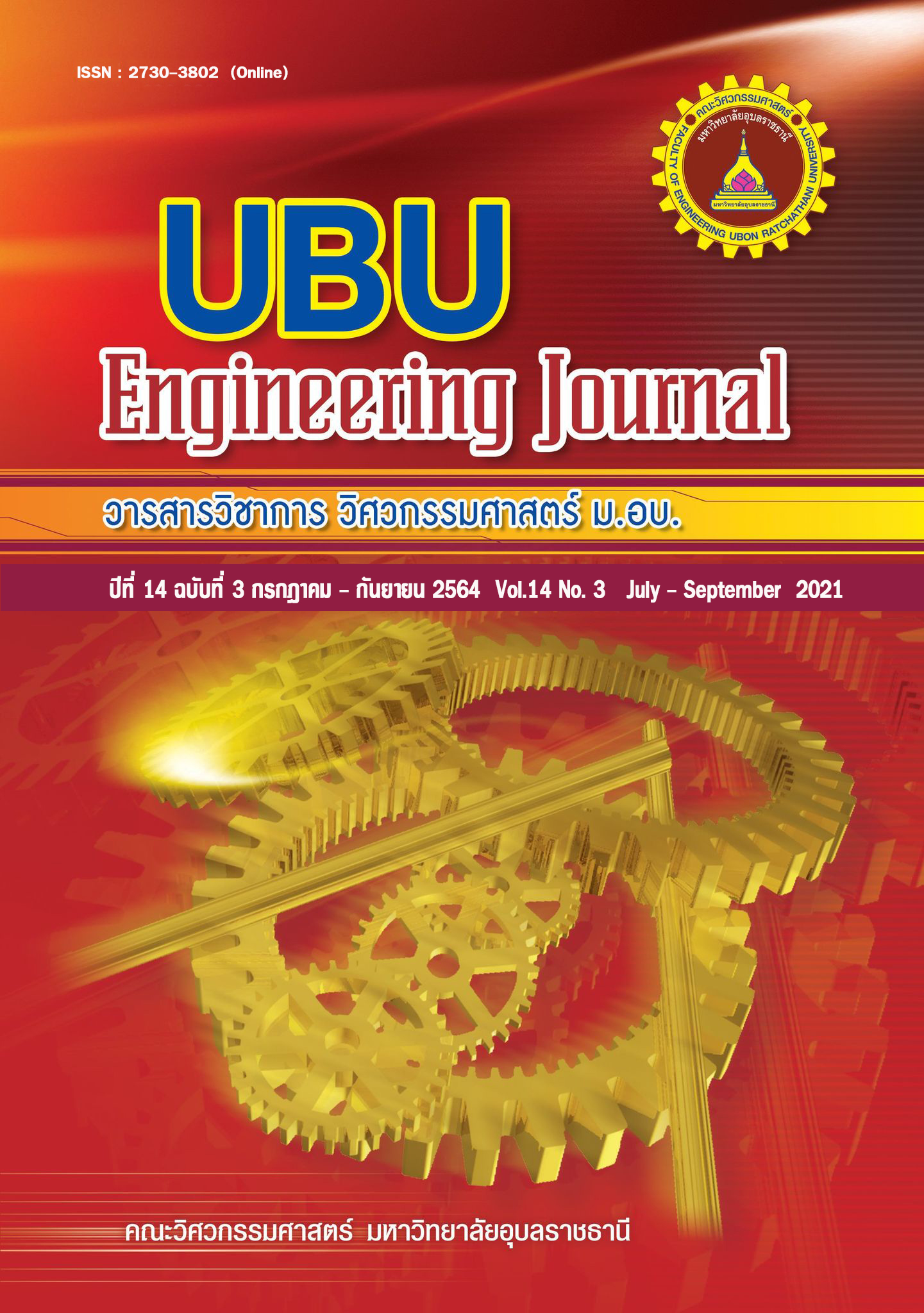UV protection of silk dyed with cassava leaves
Main Article Content
Abstract
Silk fabric was dyed with natural extract from cassava leaves (CaL). Ferric chloride (FeCl3.6H2O), alum (AlK(SO4)2.12H2O), and salt (NaCl) were used as mordant. Silk fabrics were dyed at 90 °C for 60 minutes. Then, the UV-protection efficiency of a fabric is defined by its Ultraviolet Protection Factor (UPF). The chemical functional groups of the dyes were characterized by using Fourier transform infrared spectroscopy (FTIR). The results show that Silk fabric dyed with cassava leaves showed a shade of grey. Ferric chloride and salt as mordants exhibited a black grey colour and had excellent UV protection resulted from polyphenol and tannin which was extracted from cassava leaves.
Article Details
Section
บทความวิจัย (Research Article)
References
[1] Dubrovski, PD. Woven fabrics and ultraviolet protection. Woven fabric engineering, 2010;8: 273-296.
[2] Kan CW. A Study on Ultraviolet protection of 100% cotton knitted fabric: Effect of fabric parameters. The Scientific World Journal, 2014; 1-10.
[3] มาหามะสูไฮมี มะแซ, สายใจ วัฒนเสน, ภาณุมาศ ชูพูล. การต้านรังสียูวีและการยับยั้งแบคทีเรียของผ้าไหมย้อมใบหูกวาง. วารสารวิศวกรรมศาสตร์ มหาวิทยาลัยเชียงใหม่. 2561;25(2): 113-123.
[4] ณงค์ณุช นทีพายัพทิศ. อัตลักษณ์ผ้าทอกะเหรี่ยงปกาเก อะญอ. Journal of Community Development and Life Quality. 2014;2(1): 113-121.
[5] ใจภักดิ์ บุรพเจตนา. การประยุกต์ลวดลายจากอัต ลักษณ์ ผ้าทอตีนจกแม่แจ่มเพื่อออกแบบผลิตภัณฑ์สิ่งทอเชิง วัฒนธรรมประเภทของตกแต่งบ้าน. Veridian E-Journal, Silpakorn University (Humanities, Social Sciences and arts). 2016; 9(3): 1720-1738.
[6] Nattaya P, Monthon N, Buppha S, Nootsara N, Nattadon R, Rattanaphol M. Silk fabric dyeing with natural dye from mangrove bark (Rhizophora apiculata Blume) extract. Industrial Crops and Products. 2013;49: 122-129.
[7] วรวิทย์ ศรีวิทยากูล, ธฤติ รุ่งโรจนารักษ์, ทวีป ศรีมุณี, มาหามะสูไฮมี มะแซ, ภาณุมาศ ชูพูล. การยับยั้งแบคทีเรียและการต้านรังสียูวีจากแสงอาทิตย์ของผ้าฝ้ายย้อมด้วยสีธรรมชาติเปรียบเทียบกับผ้าจีวร. RMUTI JOURNAL Science and Technology. 2019; 12(1): 27-41.
[8] Jiajia S, Pu G, Hui M. The effect of tris (2-carboxyethyl) phosphine on the dyeing of wool fabrics with natural dyes. Dyes and Pigments. 2014;108: 70-75.
[9] Moiz A, Ahmed MA, Kausar N, Ahmed K, Sohail M. Study the effect of metal ion on wool fabric dyeing with tea as natural dye. Journal of Saudi Chemical Society. 2010;14(1): 69-76.
[10] Grifoni D, Bacci L, Lonardo SD, Pinelli P, Scardigli A, Camilli F, et al. UV protective properties of cotton and flax fabrics dyed with multifunctional plant extracts. Dyes and Pigments. 2014;105: 89-96.
[11] Jothi D. Extraction of natural dyes from African marigold flower (Tagetes erecta L.) for textile coloration. Autex Research Journal. 2008;8(2): 49-53.
[12] Feng XX, Zhang LL, Chen JY, Zhang JC. New insights into solar UV-protective properties of natural dye. Journal of Cleaner Production. 2007;15(4): 366-372.
[13] Mongkholrattanasit R, Kryštůfek J, Wiener J, Viková M. Dyeing, fastness, and UV protection properties of silk and wool fabrics dyed with eucalyptus leaf extract by the exhaustion process. Fibres & Textiles in Eastern Europe. 2011;19(3): 94-99.
[14] Zhao Y, Chen M, Zhao Z, Yu S. The antibiotic activity and mechanisms of sugarcane (Saccharum officinarum L.) bagasse extract against food-borne pathogens. Food Chemistry. 2015;185: 112-118.
[15] Arasaretnam S, Venujah K. Modification of Tannin extracted from the bark of Acacia auriculiformis for the antibacterial activity and application of metal adsorption. Ruhuna Journal of Science. 2017;8(2): 90-102.
[16] Marie-Magdeleine C, Udino L, Philibert L, Bocage B, Archimede H. In vitro effects of Cassava (Manihot esculenta) leaf extracts on four development stages of Haemonchus contortus. Veterinary parasitology. 2010;173(1-2): 85-92.
[2] Kan CW. A Study on Ultraviolet protection of 100% cotton knitted fabric: Effect of fabric parameters. The Scientific World Journal, 2014; 1-10.
[3] มาหามะสูไฮมี มะแซ, สายใจ วัฒนเสน, ภาณุมาศ ชูพูล. การต้านรังสียูวีและการยับยั้งแบคทีเรียของผ้าไหมย้อมใบหูกวาง. วารสารวิศวกรรมศาสตร์ มหาวิทยาลัยเชียงใหม่. 2561;25(2): 113-123.
[4] ณงค์ณุช นทีพายัพทิศ. อัตลักษณ์ผ้าทอกะเหรี่ยงปกาเก อะญอ. Journal of Community Development and Life Quality. 2014;2(1): 113-121.
[5] ใจภักดิ์ บุรพเจตนา. การประยุกต์ลวดลายจากอัต ลักษณ์ ผ้าทอตีนจกแม่แจ่มเพื่อออกแบบผลิตภัณฑ์สิ่งทอเชิง วัฒนธรรมประเภทของตกแต่งบ้าน. Veridian E-Journal, Silpakorn University (Humanities, Social Sciences and arts). 2016; 9(3): 1720-1738.
[6] Nattaya P, Monthon N, Buppha S, Nootsara N, Nattadon R, Rattanaphol M. Silk fabric dyeing with natural dye from mangrove bark (Rhizophora apiculata Blume) extract. Industrial Crops and Products. 2013;49: 122-129.
[7] วรวิทย์ ศรีวิทยากูล, ธฤติ รุ่งโรจนารักษ์, ทวีป ศรีมุณี, มาหามะสูไฮมี มะแซ, ภาณุมาศ ชูพูล. การยับยั้งแบคทีเรียและการต้านรังสียูวีจากแสงอาทิตย์ของผ้าฝ้ายย้อมด้วยสีธรรมชาติเปรียบเทียบกับผ้าจีวร. RMUTI JOURNAL Science and Technology. 2019; 12(1): 27-41.
[8] Jiajia S, Pu G, Hui M. The effect of tris (2-carboxyethyl) phosphine on the dyeing of wool fabrics with natural dyes. Dyes and Pigments. 2014;108: 70-75.
[9] Moiz A, Ahmed MA, Kausar N, Ahmed K, Sohail M. Study the effect of metal ion on wool fabric dyeing with tea as natural dye. Journal of Saudi Chemical Society. 2010;14(1): 69-76.
[10] Grifoni D, Bacci L, Lonardo SD, Pinelli P, Scardigli A, Camilli F, et al. UV protective properties of cotton and flax fabrics dyed with multifunctional plant extracts. Dyes and Pigments. 2014;105: 89-96.
[11] Jothi D. Extraction of natural dyes from African marigold flower (Tagetes erecta L.) for textile coloration. Autex Research Journal. 2008;8(2): 49-53.
[12] Feng XX, Zhang LL, Chen JY, Zhang JC. New insights into solar UV-protective properties of natural dye. Journal of Cleaner Production. 2007;15(4): 366-372.
[13] Mongkholrattanasit R, Kryštůfek J, Wiener J, Viková M. Dyeing, fastness, and UV protection properties of silk and wool fabrics dyed with eucalyptus leaf extract by the exhaustion process. Fibres & Textiles in Eastern Europe. 2011;19(3): 94-99.
[14] Zhao Y, Chen M, Zhao Z, Yu S. The antibiotic activity and mechanisms of sugarcane (Saccharum officinarum L.) bagasse extract against food-borne pathogens. Food Chemistry. 2015;185: 112-118.
[15] Arasaretnam S, Venujah K. Modification of Tannin extracted from the bark of Acacia auriculiformis for the antibacterial activity and application of metal adsorption. Ruhuna Journal of Science. 2017;8(2): 90-102.
[16] Marie-Magdeleine C, Udino L, Philibert L, Bocage B, Archimede H. In vitro effects of Cassava (Manihot esculenta) leaf extracts on four development stages of Haemonchus contortus. Veterinary parasitology. 2010;173(1-2): 85-92.
